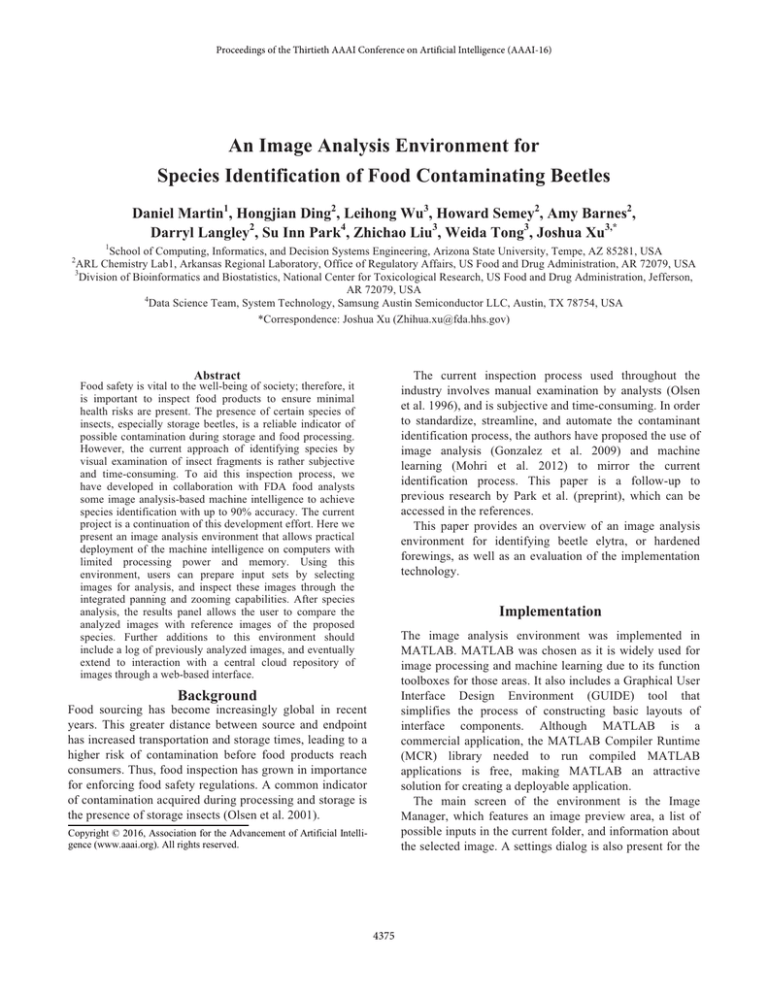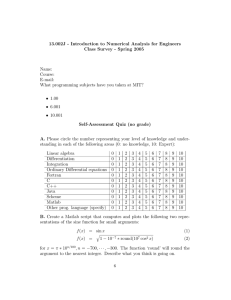
Proceedings of the Thirtieth AAAI Conference on Artificial Intelligence (AAAI-16)
An Image Analysis Environment for
Species Identification of Food Contaminating Beetles
Daniel Martin1, Hongjian Ding2, Leihong Wu3, Howard Semey2, Amy Barnes2,
Darryl Langley2, Su Inn Park4, Zhichao Liu3, Weida Tong3, Joshua Xu3,*
1
School of Computing, Informatics, and Decision Systems Engineering, Arizona State University, Tempe, AZ 85281, USA
ARL Chemistry Lab1, Arkansas Regional Laboratory, Office of Regulatory Affairs, US Food and Drug Administration, AR 72079, USA
3
Division of Bioinformatics and Biostatistics, National Center for Toxicological Research, US Food and Drug Administration, Jefferson,
AR 72079, USA
4
Data Science Team, System Technology, Samsung Austin Semiconductor LLC, Austin, TX 78754, USA
*Correspondence: Joshua Xu (Zhihua.xu@fda.hhs.gov)
2
The current inspection process used throughout the
industry involves manual examination by analysts (Olsen
et al. 1996), and is subjective and time-consuming. In order
to standardize, streamline, and automate the contaminant
identification process, the authors have proposed the use of
image analysis (Gonzalez et al. 2009) and machine
learning (Mohri et al. 2012) to mirror the current
identification process. This paper is a follow-up to
previous research by Park et al. (preprint), which can be
accessed in the references.
This paper provides an overview of an image analysis
environment for identifying beetle elytra, or hardened
forewings, as well as an evaluation of the implementation
technology.
Abstract
Food safety is vital to the well-being of society; therefore, it
is important to inspect food products to ensure minimal
health risks are present. The presence of certain species of
insects, especially storage beetles, is a reliable indicator of
possible contamination during storage and food processing.
However, the current approach of identifying species by
visual examination of insect fragments is rather subjective
and time-consuming. To aid this inspection process, we
have developed in collaboration with FDA food analysts
some image analysis-based machine intelligence to achieve
species identification with up to 90% accuracy. The current
project is a continuation of this development effort. Here we
present an image analysis environment that allows practical
deployment of the machine intelligence on computers with
limited processing power and memory. Using this
environment, users can prepare input sets by selecting
images for analysis, and inspect these images through the
integrated panning and zooming capabilities. After species
analysis, the results panel allows the user to compare the
analyzed images with reference images of the proposed
species. Further additions to this environment should
include a log of previously analyzed images, and eventually
extend to interaction with a central cloud repository of
images through a web-based interface.
Implementation
The image analysis environment was implemented in
MATLAB. MATLAB was chosen as it is widely used for
image processing and machine learning due to its function
toolboxes for those areas. It also includes a Graphical User
Interface Design Environment (GUIDE) tool that
simplifies the process of constructing basic layouts of
interface components. Although MATLAB is a
commercial application, the MATLAB Compiler Runtime
(MCR) library needed to run compiled MATLAB
applications is free, making MATLAB an attractive
solution for creating a deployable application.
The main screen of the environment is the Image
Manager, which features an image preview area, a list of
possible inputs in the current folder, and information about
the selected image. A settings dialog is also present for the
Background
Food sourcing has become increasingly global in recent
years. This greater distance between source and endpoint
has increased transportation and storage times, leading to a
higher risk of contamination before food products reach
consumers. Thus, food inspection has grown in importance
for enforcing food safety regulations. A common indicator
of contamination acquired during processing and storage is
the presence of storage insects (Olsen et al. 2001).
Copyright © 2016, Association for the Advancement of Artificial Intelligence (www.aaai.org). All rights reserved.
4375
image processing and
competitive at this stage.
user to change the number of subimages taken as well as
the current neural network to use.
machine
learning
make
it
Conclusion
This paper presents an image analysis environment to
streamline routine food contaminant identification. It is
easy to use, standardized, and reproducible. By reducing
the manpower and time costs of inspection, this program
aids in increasing processing capacity. Its analysis is faster
than current manual inspection.
In the future, this program can be enhanced in several
ways, such as allowing multiple result windows to be open
at once; being able to identify hairs, bird feathers, and
other contaminants; and finally, porting the system to a
web platform.
Figure 1: Choosing Images for Analysis.
Once the analysis is finished, the Analysis Report
window appears. This window contains preview areas for
the input and reference images, as well as the resulting
species name and confidence level. As in the Image
Manager window, the user can zoom and pan both images
for better visual comparison and confirmation. Currently
the program only returns the resulting species with the
highest confidence level out of the 15 reference storage
beetle species. Both limitations, i.e., the number of
resulting candidates and the number of reference species
included in the original model by Park et al., will be
addressed in the future. Finally, the results can be printed
out to an HTML log for later reference.
Acknowledgements
Daniel Martin and Su Inn Park are grateful to the National
Center for Toxicological Research (NCTR) of U.S. FDA
for the Summer Student Research Program administered
by the Oak Ridge Institute for Science and Education. The
authors appreciate the critical review of the manuscript by
Dr. Vikrant Vijay and Mr. Joseph Meehan of FDA/NCTR.
Disclaimer
The views presented in this article do not necessarily
reflect the views of the US Food and Drug Administration.
References
Gonzalez, R. C.; Woods, R. E.; and Eddins, S. L. 2009. Digital
Image Processing Using MATLAB, 2nd ed. Knoxville, TN:
Gatesmark Publishing.
Mohri, M.; Rostamizadeh, A.; and Talwalkar, A. 2012.
Foundations of Machine Learning. Cambridge, MA: The MIT
Press.
Olsen, A. R.; Gecan, J. S.; Ziobro, G. C.; and Bryce, J. R. 2001.
Regulatory Action Criteria for Filth and Other Extraneous
Materials V. Strategy for Evaluating Hazardous and
Nonhazardous Filth. Regulatory Toxicology and Pharmacology
33(3):363-392.
Olsen, A. R.; Sidebottom, T. H.; and Knight, S. A. 1996.
Fundamentals of Microanalytical Entomology: A Practical Guide
to Detecting and Identifying Filth in Foods. Boca Raton, FL:
CRC Press.
Park, S.; Bisgin, H.; Ding, H.; Semey, H.; Langley, D.; Tong, W.;
and Xu, J. Species Identification of Food Contaminating Beetles
by Recognizing Patterns in Microscopic Images of Elytra
Fragments. Preprint, submitted September 9, 2015.
Figure 2: Results of an Analysis.
During implementation, the authors have overcome
several performance challenges with MATLAB in its
functionality and design. For example, compiled
MATLAB applications can run only with the MCR of the
same version as the compiler. Compiling MATLAB code
with a different version may affect the program, as the
implementation of functions might change between
versions. The task of compiling MATLAB is further
complicated by the absence of a toolbox dependency
checker. Finally, the official documentation provides
mostly rudimentary instructions for using GUIDE and
MATLAB Compiler, forcing the developer to the
unofficial forums for most common problems.
While MATLAB presents a few challenges, especially
with its user interface and compiler tools, its strengths in
4376



